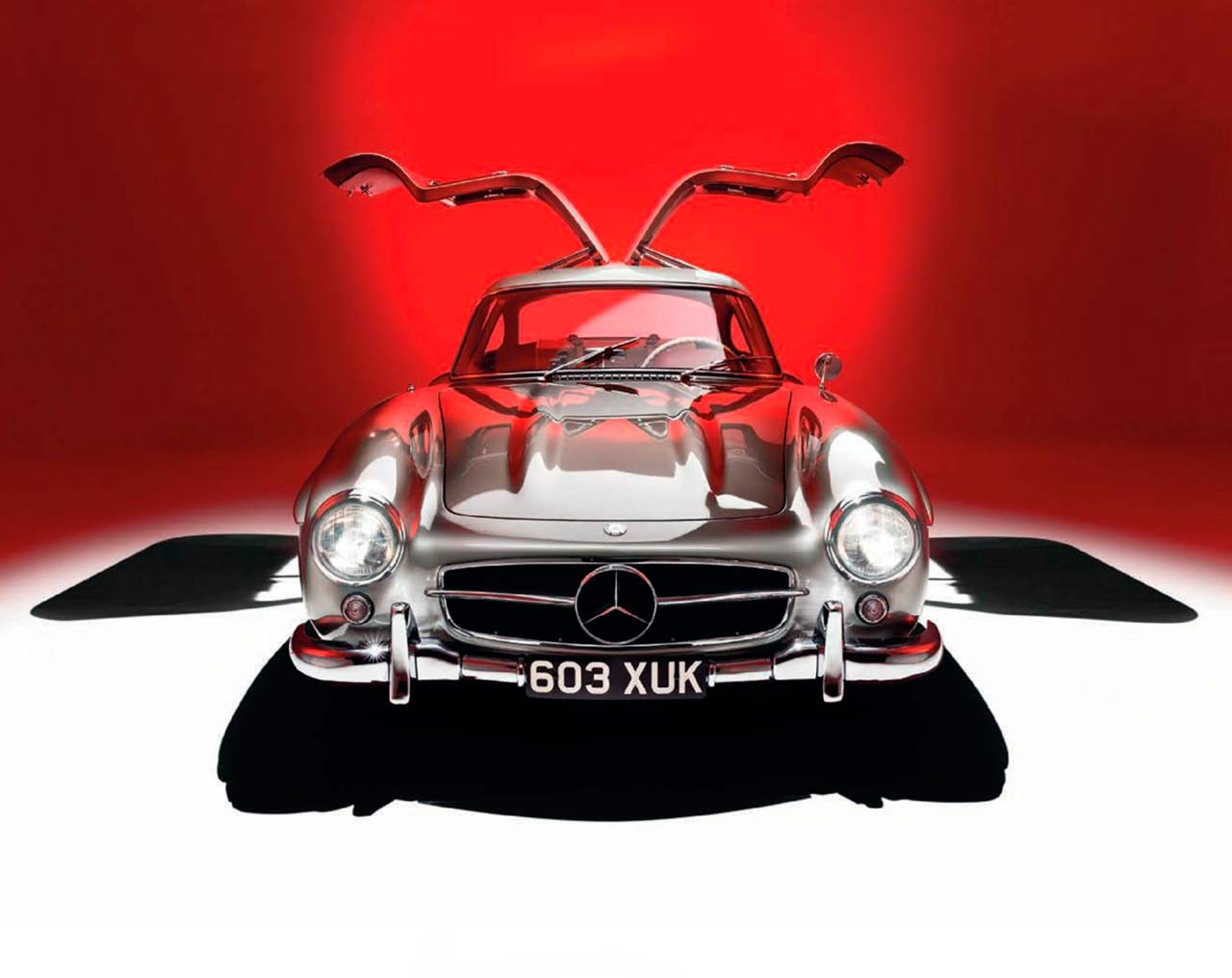
Merc’s extraordinary ’50s supercar was a technological marvel. Mercedes’ masterpiece Based on an all-conquering racing car, the 300SL redefined the marque. 160mph in 1954! John Surtees on how the 300SL set the standard. Stuttgart’s greatest work of art. The Mercedes 300SL blends sophisticated engineering with unforgettable styling, says Malcolm Thorne as he charts its development. Photography Tim Andrew/LAT/Mercedes-Benz.
GULLWING GLORY
When Laurence Pomeroy of The Motor reported spotting a group of Mercedes veterans spectating at Le Mans in 1951, few of his readers could have imagined that a legend was in the making. In spite of the firm’s pre-war motorsport dominance, there were scant clues to suggest that in 1952 Stuttgart would score a series of victories that would seal its place among the emerging new order. Mercedes-Benz was a manufacturer of well-engineered vehicles of excellent quality, but, having barely survived the bombing that had destroyed its home town, the name was no longer the synonym for racing success that it had been a dozen years earlier.
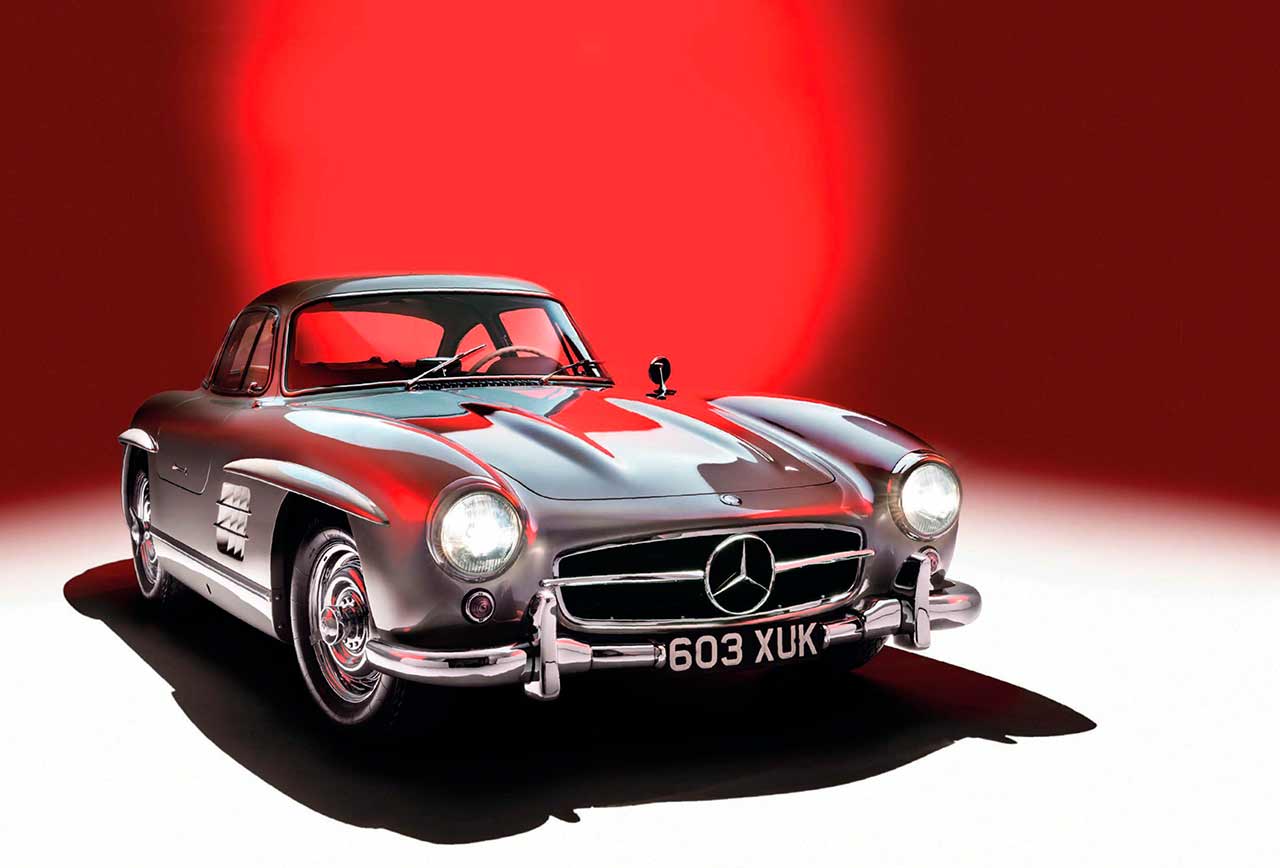
More significantly, in a dollar-hungry Europe, Mercedes certainly didn’t offer a rival to the exciting new models from Jaguar and Ferrari. That, however, was all about to change. Early proof came the following May, when Karl Kling and Hans Klenk finished second on the Mille Miglia driving an oddly shaped UFO dubbed W194, or 300SL. Although much of the componentry had been borrowed from production models, light weight and fine aerodynamics made it a highly effective weapon. The Italian event was the only occasion in 1952 that the W194 failed to nail top spot. The Bern GP ended in a Mercedes 1-2-3, while Stuttgart would take the first two places at Le Mans, plus an emphatic 1-2-3-4 at the Nürburgring. In the season finale, the perilous cross-Mexico dash that was the Carrera Panamericana, the W194 once again seized a 1-2 – and this in spite of a hair-raising high-speed altercation with a large bird that smashed through the windscreen of Kling’s winning car at 140mph.
Over the winter, an improved version – smaller, lighter and more angular – was prepared under the leadership of legendary British-born engineer Rudolf Uhlenhaut. But with finite resources, and having done the groundwork for its forthcoming assault on Grand Prix racing, Mercedes retired the W194. It had performed its task with aplomb, but was no longer needed.
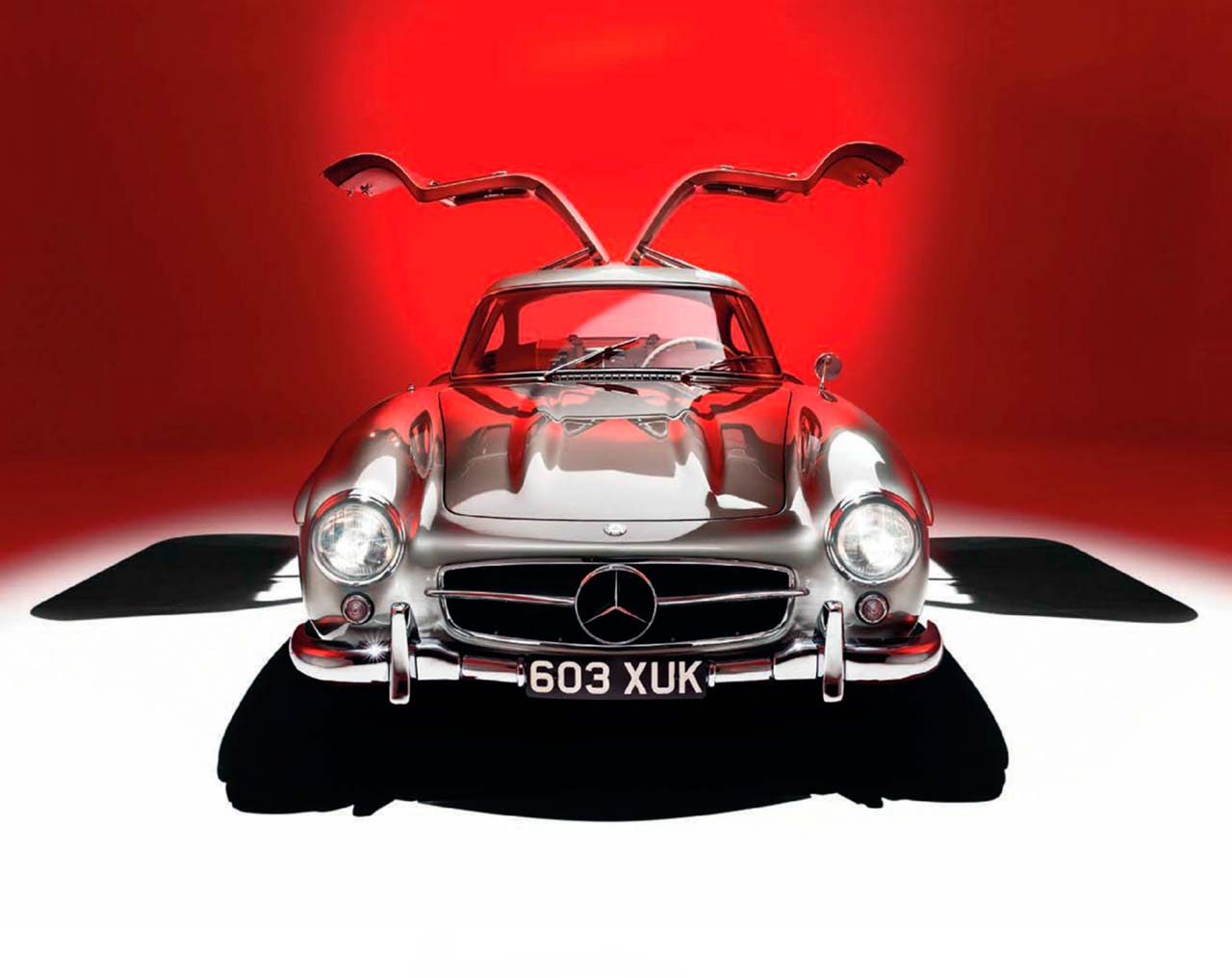
The story might well have ended there, had it not been for the firm’s recently established US importer, Max Hoffman. Having generated huge interest when he turned up at a Long Island race meeting with Kling’s Mille Miglia car, the Austrian-born entrepreneur was convinced that he could sell a production version. Mercedes management resisted his overtures, but, not one to be discouraged, he famously convinced the factory by placing a firm order for 400 cars.
Then, as now, money was a persuasive force, and the road-going variant – the W198 – was unveiled at the International Motor Sports Show in New York on 6 February 1954. Strikingly futuristic in appearance – even without those signature doors it would be a breathtaking thing to behold – it was tautly sophisticated in a way that the utilitarian W194 simply hadn’t been. The racer’s W154-inspired grille was gone, in its place a broad opening with a vast three-pointed star as its focal point. Cooling vents on the flanks improved underbonnet airflow – a W194 weakness – while strakes over the wheelarches were claimed to provide further aerodynamic benefit. Never before or since has the science of airflow looked this good. “The 300SL embodies timeless design,” says Gorden Wagener, Mercedes’ current styling chief. “It is undoubtedly one of the most beautiful cars ever, and I’m sure that I’m not alone in including it in my top 10 automotive designs.
It still serves as inspiration. Current design language is of course different – today we live in a different time – but I like to borrow elements from the past and let them flow into the styling of current models. For example, [look at] the long bonnet with vertical grille, the long wheelbase and short overhangs of the AMG GT – all perfectly balanced attributes. As a sports car, the Gullwing is definitely a work of art.”
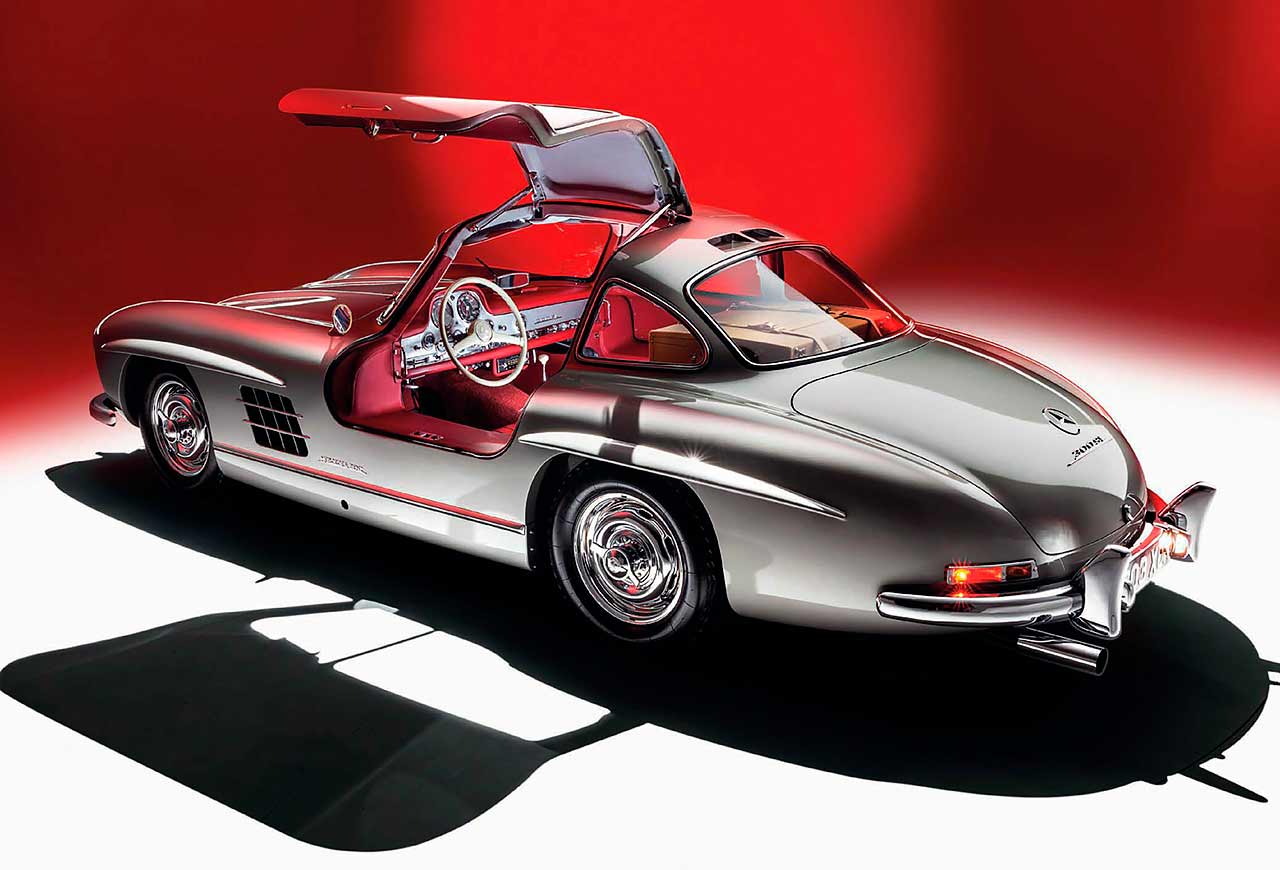
Yet this was no veneer of visual artifice. Unlike the racer, only the doors, bootlid and bonnet were made out of aluminium, although 29 special-order alloy-bodied cars would eventually be constructed. What lay beneath the largely steel skin was breathtakingly sophisticated. Where rivals – and, indeed, the lookalike 190SL W121 roadster – relied upon mundane ironmongery, the W198 featured the same radical construction as its progenitor. There would be no heavy steel girders weighing down this most super of cars; instead, a beautifully engineered spaceframe – described by Motor Sport’s Bill Boddy in 1954 as bicycle tubes! – provided strength in abundance, in spite of its paltry 80kg weight. A forward-thinking application in a racing car, it was nothing short of revolutionary in a model intended for the road.
The future didn’t end there, either. Nestling among those slimline tubes was a gloriously avant garde powerplant. It was hidden beneath an improbably low bonnet, the humped strakes on which are a corollary of the panel being pulled tightly over the engine. The left-hand one is a dummy, added for symmetry.
A development of the iron-block in-line ‘six’ that had powered the W194 (itself an evolution of the unit to be found in the 300 ‘Adenauer’), it nonetheless broke exciting new ground. Gone were the W194’s carburettors, to be replaced by an aviation-inspired direct-injection system – a world first on a four-stroke production car.
Remarkably, the work that had gone into the dry-sump M198 unit meant that, in spite of it being incredibly docile, at a quoted 240bhp it was more powerful than the competition version that had won at Le Mans two years previously. Here, in 1954, was a car that – with the optional 3.25:1 axle – could pull all the way from 15 to nigh-on 160mph in top gear.
Think about that in the context of the time. Britain’s cheapest new car in 1954, the sit-up-and-beg Ford Popular – which came in at only £390, compared to a whopping £4392 for the Mercedes – offered its patient owner a largely theoretical top speed of just 60mph. In standard form, meanwhile, even an Aston DB2/4 or Jaguar XK140 would have struggled to exceed 120mph. Of course, in pre-motorway Britain – the first section of the M1 wouldn’t open until 1959 – it’s unlikely that the majority of motorists had ever exceeded half of that figure, so a racebred bolide that could cover two and a half miles a minute must have offered all the exoticism of interplanetary space travel.
That the Gullwing featured drum brakes may sound rather less science fiction, and at odds with its futuristic build and lightning pace, but if truth be told, the vast Alfin drums were more than up to the job of arresting the 300SL from speed. Indeed, in 1955 John Bolster commented in Autosport that the brakes were plenty powerful enough to lock the wheels at 140mph, ‘with all the accompanying drama that one might expect’. And drama was the operative word, because for all its delectable sophistication, the Gullwing also had an attention-grabbing characteristic that you ignored at your peril.
Just like those other perennial German favourites, the Volkswagen Beetle and Porsche 356, the Gullwing is blessed – or blighted – with swing-axle rear suspension. General consensus is that, driven with a modicum of sense, the 300SL is a magnificent thing. It gets a bit hot inside, but balances that by making a wonderfully inspiring noise. Yet legend also has it that anyone foolish enough to provoke the car – especially with values currently topping £1million – is either fearless in the extreme, or desperately lacking in imagination.
In period, SCH Davis wrote in Autocar that he ‘did not think that such a car should be available to the inexperienced for ordinary road use’ while John Bolster opined that ‘very few drivers would be at home in it without a great deal of practice’. Suspecting that perhaps they were just being overly cautious, I asked a trusted source.
“In standard form, the 300SL was not a car that you took any liberties with at all,” says no less an authority than 1964 Formula One World Champion and long-term Gullwing owner John Surtees. “I first drove one in 1956, when I had just won the motorcycle World Championship. I took it home and the local doctor was very keen so I asked if he would like to come for a run. He eagerly agreed, so we took it to a section of road that I knew quite well. Coming out of the speed-restricted area, I accelerated and came to a left-hand curve just as it started to rain. I ended up going down the road with a lot of oppositelock as the back end broke away.
My passenger was speechless until we got back home, at which point he beseeched my mother not to let me buy one because he thought I would kill myself!
“These days, uprated springs and different damper settings make the car more predictable, and with the tyres that are now available you can make further improvements. Without them, you needed to give it your total attention if you were to drive it quickly and be very aware of its ability to lose the rear end. It wasn’t until the Roadster was introduced that the lessons from the race track were incorporated.”
“If I’d designed it, I would have used either a de Dion or fully independent rear suspension,” says Gordon Murray, the legendary engineer who was behind the car that was arguably the Gullwing’s 1990s equivalent – the McLaren F1.
“The swing-axle rear was a dreadful choice. It was the most advanced road car of its time and had great styling, but it was a flawed design. I also would have worked much harder on packaging the fuel tank in a position that had a less dramatic effect on centre-of-gravity shift.
“It was an extremely brave decision to put the 300SL into production because the fuel injection system was underdeveloped and true spaceframes are difficult to produce in volume. Although it was a bad decision to use the latter, its inclusion helps to make the SL a great classic today. That, plus the relatively light weight, were great engineering achievements, and the aerodynamic work deserves a place in history. Those facts are backed up by the racing connections with the design – always a sign of a great car. Also, I think the styling was very influential in the 1950s, and remains so today.”
“There are some similarities between the Mercedes and the McLaren,” he reflects. “Both were the fastest cars of their era, were light and used advanced chassis technology – and both featured dramatic doors!”
Far from being a stylist’s whim, the 300SL’s gullwing design was an engineering necessity that was dictated by the need to provide reasonable access to the cabin. Observe a naked 300SL chassis and you’ll notice that Boddy’s bicycle frame has its crossbar running right across what would normally be the door aperture. Unlike the countless aesthetic imitations that have followed, without its trademark feature, entry to and egress from the car would be all but impossible. After just three years and 1400 examples, the Gullwing was withdrawn from production in 1957, to be replaced by the 300SL Roadster. A more predictable machine to hustle, the new variant benefited from improved rear suspension and easier access thanks to its conventional doors, but, for many, the original remains by far the more charismatic of the two.
It is the sort of car that leaves you itching to embark on a high-speed pan-European blast. Who cares that the gearbox whine might become tiring? I want nothing more than to stretch the 300SL’s legs in homage to the racers whose achievements behind the wheel of the W194 went on to give us one of the greatest and most iconic designs ever.
“Despite its problems, the car is still a very special one,” concludes Surtees. “Not only because of its history and how it came about, but also because of the way in which it was constructed. Sitting there in that cockpit and starting up the engine is always the beginning of a special experience.”
Thanks to Robert and Tanya Lewis; Kienle Automobiltechnik (0049 7152 901 630; www.kienle.com); Mercedes-Benz
Tech and photos
TECHNICAL DATA 1955 Mercedes-Benz 300SL ‘Gullwing’ W198
Engine 2996cc straight-six, OHC, Bosch mechanical fuel injection
Power 240bhp @ 6100rpm
Torque 217lb ft @ 4800rpm
Transmission Four-speed manual, rear-wheel drive
Steering Recirculating ball
Suspension Front: double wishbones, coil springs, anti-roll bar.
Rear: swing axle, radius arms, coil springs
Brakes Drums, servo assisted
Weight 1252kg
Performance Top speed 135mph. 0-60mph 8.8sec
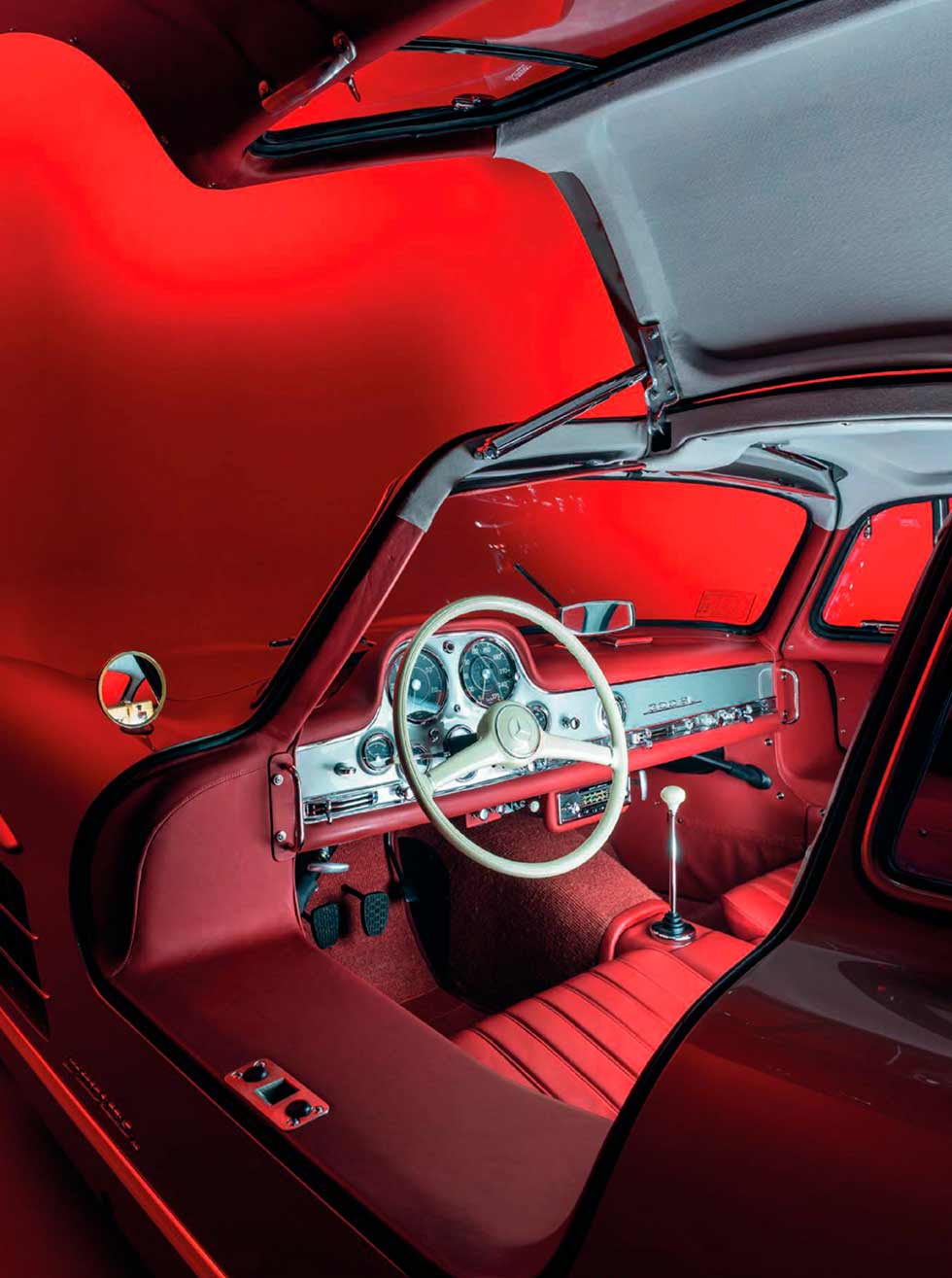

‘EVEN WITHOUT THOSE DOORS, THE MERCEDES WOULD BE A BREATHTAKING CAR TO BEHOLD’
“YOU NEEDED TO GIVE IT YOUR TOTAL ATTENTION IF YOU WERE GOING TO DRIVE IT QUICKLY” JOHN SURTEES
Selling the dream
“I first saw a Gullwing in 1955 at the age of 23,” says long-term 300SL W198 owner and former salesman Ivan Page-Ratcliff. “I was working at Brooklands of Bond Street, which was a distributor for Aston Martin, Lancia and Jensen, as well as for Mercedes-Benz. When the first 300SL arrived, I was appointed to demonstrate it to potential customers – a task I performed with some enthusiasm!
“It was really the first supercar, and so far superior to anything else I had driven. There was a good deal of sales resistance, though, not least because it was available only in left-hand drive and the price was the same as a Rolls- Royce. Also, the war had finished just 10 years earlier and there was still considerable animosity towards Germany. I think we sold only about 15-20 at Brooklands, out of perhaps 50 cars in the whole of the UK.
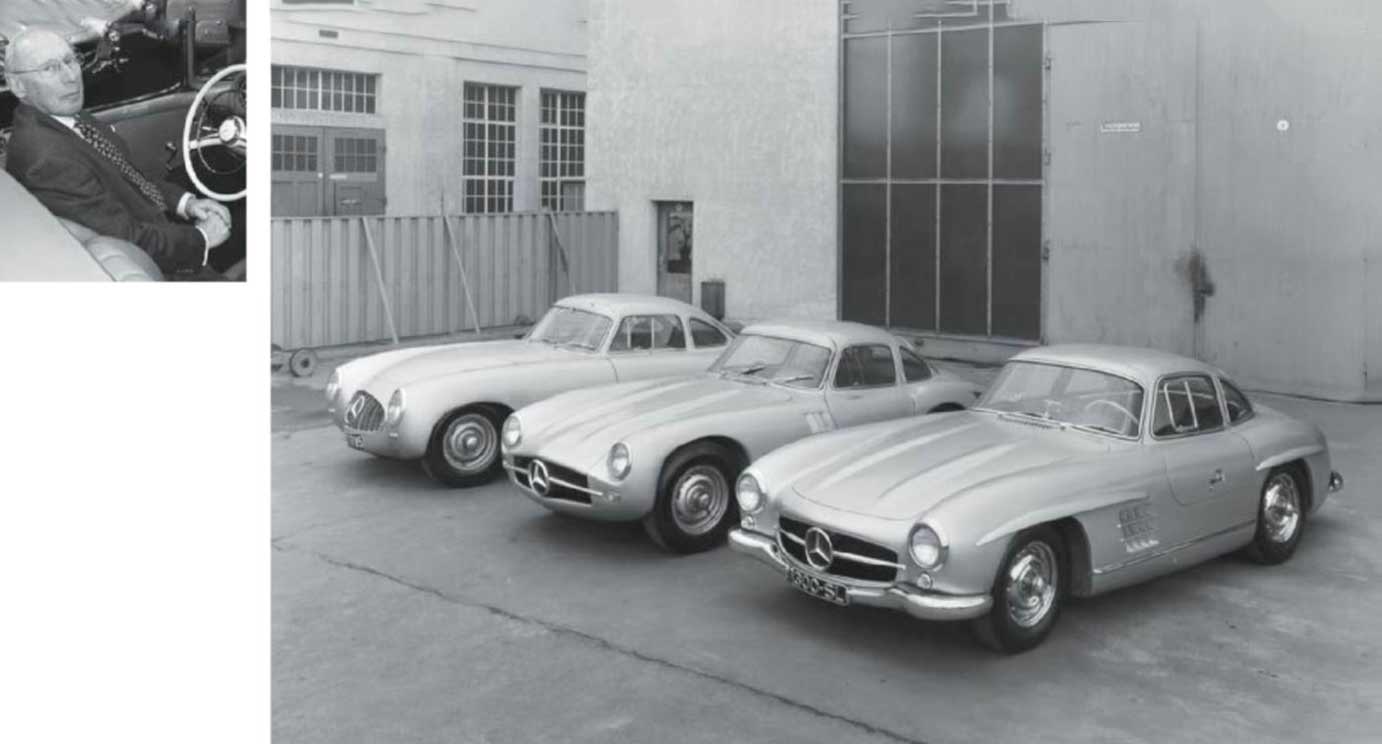
“The engineering and build quality were far in excess of any other car but it was the shape and, of course, the door configuration that were the most striking features. The 300SL was suitable for daily driving, but the enormous capacity of the dry-sump engine meant that it was difficult to achieve a good working oil temperature: the car was designed to maintain 6000rpm for hours on end without blowing up! “I have owned mine for 20 years and it has only once tried to bite me. That was my fault for taking my foot off the accelerator in a fast bend on a greasy surface. The best adventure I’ve had was on the 2004 Classic Adelaide Rally. It was the 50th anniversary and there were more than 20 Gullwings there from all over the world. Between us, we clocked up about 50,000 miles – mostly flat out – and none of the cars had any mechanical problems; what a tribute to the original design and engineering excellence.”
Competition class
Although the W198 was an evolution of the racer that had so dominated the 1952 season, it was first and foremost a civilised road car. With its astonishing performance, however, it lent itself beautifully to competition use. Stirling Moss and Denis Jenkinson used one to learn the route ahead of their famous victory on the Mille Miglia in 1955. Perhaps less well known – no doubt overshadowed by Moss’ recordbreaking performance in the 300SLR – is that the road-going model scored an impressive 1-2-3 class win on the gruelling Italian event in the same year.
The Gullwing was also a successful rally car: Olivier Gendebien drove one to a win on the 1955 Liège- Rome-Liège enduro, while Werner Engel won the European rally championship in the same year. In 1956, ‘Wild’ Willy Mairesse repeated his Belgian compatriot’s victory on the Liège-Rome-Liège, and Walter Schock matched Engel by claiming the European crown. Stirling Moss, meanwhile, brought a Gullwing home second on the 1956 Tour de France. Encouraged by the result, he returned in 1957 but struggled against a vast Ferrari works entry, eventually finishing a creditable fourth.
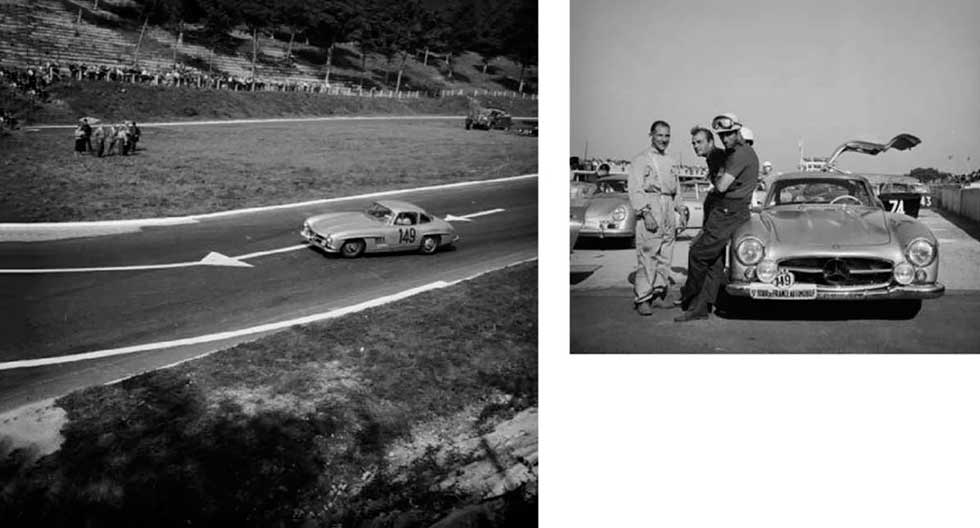
Specialist’s view
“Demand for the 300SL is strong,” explains Marc Kienle of German specialist Kienle Automobiltechnik. “The market is stable, and prices for the best cars – with good history and either in original condition or perfectly restored – are still increasing.
“You would be looking at £1.25-1.5million for an excellent example, depending on history and whether it’s fitted with the desirable Rudge wheels. You would get an average car for £700-950,000, with projects in the region of £450-650,000. There are very few of those around, though – even average examples are now often being restored. A full rebuild will always take at least 1500 hours and can go up to 2500 hours, depending on the condition of the car beforehand. That equates to a bill of about £270-350,000 – plus VAT…
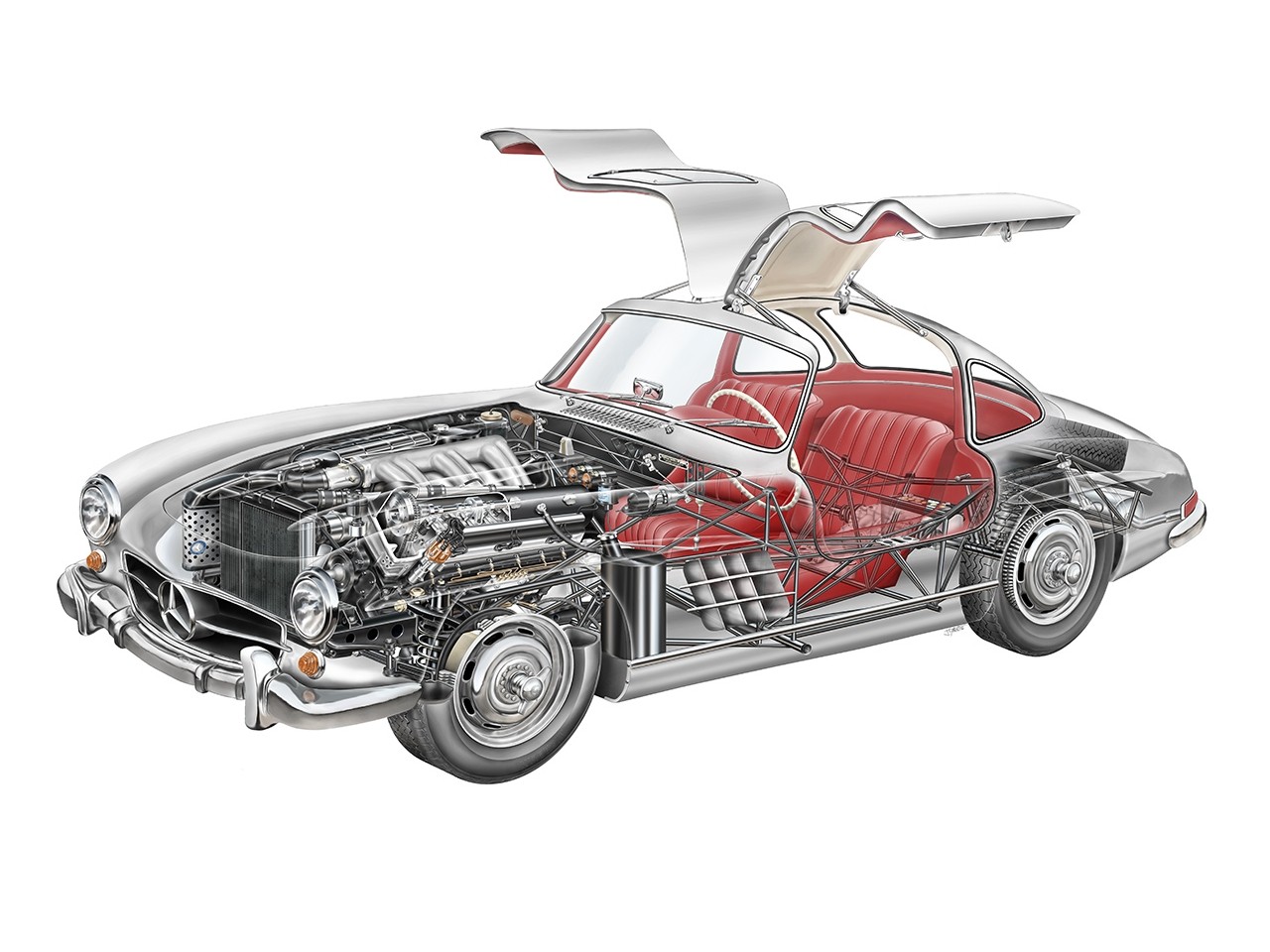
“The 300SL is a wonderful car to drive and to use, and reliable as long as it’s restored and maintained correctly. It is very stable and, for a 60-year-old sports car, is quite comfortable. It can get hot in the summer but there are modifications that can help to cool it down. “An improved clutch and cooling fan, as well as electronic ignition and a more powerful alternator, are popular modifications among owners. Overall, though, it is a super car. In general, headaches only tend to arise from incorrect repairs and poor-quality restorations.”






